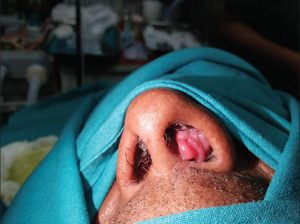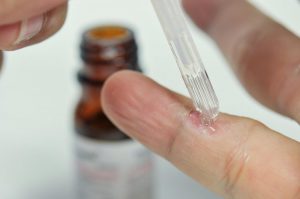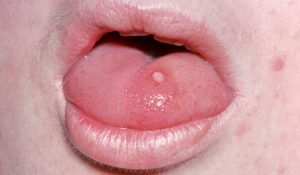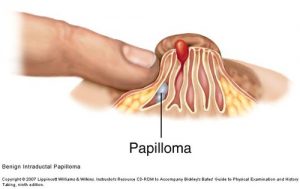Papillomas in any part of the body always cause discomfort. Under «external security» there is a significant risk. There are places on the body where growths are especially dangerous because they can be easily injured, which leads to their growth or cancer. Particular attention should be paid when the papillomas pop up on the tongue, since it can be touched during elementary processes of life activity, it forms scratches and wounds that can easily be infected. Therefore, it is necessary to resolve this issue as quickly and as efficiently as possible. Find out how to do this!
![1-squamous-cell-papilloma-on-tongue-dr-p-marazziscience-photo-library[1]](https://papillomas.org/wp-content/uploads/2019/10/1-squamous-cell-papilloma-on-tongue-dr-p-marazziscience-photo-library1-300x199.jpg)
Contents
- What Are the Types of Tongue Papillomas?
- Causes of Papilloma on Tongue
- How to Diagnose Tongue Papillomas?
- How to Treat Squamous Papilloma of Tongue
- How to Remove Papilloma on Tongue?
What Are the Types of Tongue Papillomas?
Papilloma tongue is most susceptible to injury in the process of human life. Papillomas on the tongue is a very unpleasant phenomenon, both from a cosmetic point of view and sensations. They have been extensively studied in order to better understand their nature and accordingly determine effective methods for their removal.![fibroma-on-the-tongue-dr-p-marazziscience-photo-library[1]](https://papillomas.org/wp-content/uploads/2019/10/fibroma-on-the-tongue-dr-p-marazziscience-photo-library1-300x199.jpg)
So there are two classifications of papillomas on tongue depending on the selected trait. On papilloma tongue pictures, you will see the following types:
- Flat: they rise no more than 2 mm above the mucosa, but at the same time they tend to expand to 15 mm and have a light shade, usually appear one at a time;
- Filamentary: protrude above the surface to 4 mm, but limited in width, stand out in a shade slightly different from the color of the mucosa itself, prefer to appear in several pieces;
- Squamous papilloma tongue: resemble peculiar nipples with a pointed tip, differ in a light-colored shade.
The second sign by which tumors are distinguished is their localization. According to the location in the oral cavity, there are papillomas: on the upper side of the tongue; at the root of the tongue; on the tongue; under the tongue; on the cheek from the inside; on the lip from the inside. It is worth noting that since practically any such growth in the oral cavity is to be removed, the further it settles down or completely hides, the more difficult will be the procedure for its elimination.
Causes of Papilloma on Tongue
Among the papilloma tongue causes, the main cause of the human papillomavirus is transmission from an infected person. Often, there are cases when the child got the virus from the mother during childbirth. Therefore, almost every person is, in fact, a carrier, but at the same time, if not to create suitable conditions, the disease will never manifest itself. Infection with papillomavirus possible with the birth of a child from the infected mother.
However, there are a number of factors that can cause the activation of the disease, which will begin to manifest itself externally. Check tongue papilloma causes: one or more of the following factors will be sufficient to cause this disease:
- Constant stress;
- The use of unwashed fruit and vegetables;
- Bad habits;
- The long period of taking antibiotics;
- Chronic diseases;
- Elderly age;
- Non-compliance with personal hygiene.
It is worth noting that if a person’s immune system is strong enough, then even in the presence of a virus, papillomas in the tongue may never appear, or if they arise, they can pass on their own. This is especially true of children who undergo tremendous changes during development. Papillomas in the child’s tongue may be due to the fact that babies like to pull various dirty objects into their mouths.
Also, children may have squamous papilloma on tongue due to scratches and wounds, which eventually became infected. Nevertheless, if we take timely measures to strengthen the immune system, clean the mouth and prevent visits to a specialist, then serious consequences can be avoided.
How to Diagnose Tongue Papillomas?
It is quite difficult to determine immediately that there is a tongue papilloma. If it is in a prominent place, then looking at your mouth in the mirror, you can detect it. There is a situation when papillomas are located above the tongue, then there may be a slight discomfort or even a slight itch in that area. In other cases, it should be noted that a tumor has appeared in the mouth only when it is injured and causes pain.
So, as a rule, the symptoms become noticeable only after the papilloma has been touched, for example, if it is a papilloma under tongue and it has begun to either cause a nagging pain, or even bleed. There is no other symptom as such, and therefore it happens that the tumor appeared and passed away on its own, but the person did not even guess about it.
Tongue papilloma pictures can’t help to determine papillomas 100%. To diagnose the virus itself is quite simple. Most often this happens through an external examination of a specialist who should be addressed in such a situation. Then, an analysis of the polymerase chain reaction is carried out, the meaning of which is to detect the DNA of the virus itself and thus learn more about it. In the future, this allows you to select the appropriate treatment.
In order to avoid tongue papilloma, it is necessary, first of all, to monitor your health. Proper nutrition, healthy sleep, the right day regimen, the absence of bad habits, personal hygiene, etc., helps to strengthen the whole body.
If the disease manifested itself, then you should remember what papillomas in the tongue are and why they appear. This will allow you to choose an effective treatment. However, it is worth remembering that the course of treatment should be prescribed only by a specialist.
How to Treat Squamous Papilloma of Tongue
When papilloma of tongue is determined, it is necessary to find out how to treat the disease. First you need to understand whom to consult. As a rule, in order to remove papillomas without![shutterstock_558453145-1600x1067[1]](https://papillomas.org/wp-content/uploads/2019/10/shutterstock_558453145-1600x10671-300x200.jpg) external intervention, it is necessary to carry out drug treatment, which consists of:
external intervention, it is necessary to carry out drug treatment, which consists of:
- Vitamin A oil solution (retinol) is responsible for the health of the skin and mucous membranes;
- Treatment of the damaged area with an oily solution of vitamin A;
- The use of interferon topically.
- Reception of immunomodulators (for example, Panavir), which also possess antiviral properties.
Particular attention should be paid if the papillomas occur in a pregnant woman. Here, taking medications should be very careful, because they can affect the overall processes not only in the mother’s body, but also in the child. As a rule, antiviral drugs, such as Viferon, etc., may be recommended for pregnant women.
The question whether to remove the tongue papilloma of the expectant mother can only be answered by a doctor who is aware of all the processes in this particular case. Since there is a high risk of complications at the time of disposal and after, the attending physician may have less radical ways to remove unpleasant tumors. He/she may prescribe a secondary treatment that will be directed purely to fight the virus.
How to Remove Papilloma on Tongue?
In order to remove an unpleasant growth in the mouth, practically the same methods are used as for removing it on any other place. It is worth noting that the sensations from the procedure will differ significantly, since the oral cavity is more sensitive, and besides, everything in it heals a little longer. However, if the decision is made, you should decide how to get rid of papillomas and how to make it less painful and risky. There are 4 main methods of removing papillomas on tongue, which differ from each other in pain, the duration of the recovery period and, of course, cost.
These are methods such as:
- Laser removal: the least painful, quick recovery, quite expensive;
- Cryodestruction: painfully, heals for a relatively long time, average cost;
- Radio wave surgery: painful, heals depending on the degree of damage, the cost based on the complexity of the operation;
- Removal by current: painful, fairly long healing, cost depending on the process.
It should be clarified that when papillomas appear in the child’s tongue, you should consult your doctor about the urgent need for their removal. As a rule, such an operation is not performed for children, however, if a decision was made to remove tongue papillomas, it is better to do this with anesthesia, since it can be difficult for a child to sit still.
Having decided on which doctor to go to, but at the last moment, changing the mind, some people tend to try to get rid of papillomas on their own at home. However, they do not think about whether you can do it yourself, especially if the growth is already sore. When you try to get rid of papillomas on the open surface of the body, it is one thing but if you want to remove papillomas o n tongue, you need to understand that is more dangerous because you can damage the oral mucosa.
Therefore, it is categorically impossible to engage in self-treatment and removal of growths with the help of homemade remedies because, in the end, this can lead to cancer. If desired, traditional medicine can act as a supplement to the main therapeutic papilloma tongue treatment course, which is usually in the use of herbal infusions to strengthen the immune system and reduce the strength of the virus.

![benign-tumours[1]](https://papillomas.org/wp-content/uploads/2019/10/benign-tumours1-300x192.jpg)

![hpv-1[1]](https://papillomas.org/wp-content/uploads/2019/10/hpv-11-300x225.jpg)

![1468520510154[1]](https://papillomas.org/wp-content/uploads/2019/10/14685205101541-300x225.gif)


![Why-is-there-blood-in-my-urine-722x406[1]](https://papillomas.org/wp-content/uploads/2019/10/Why-is-there-blood-in-my-urine-722x4061-300x169.jpg)
 Human papillomavirus (HPV) has been known for quite a while; for quite a long time, it was the papillomaviruses that reason body moles. As per singular appraisals of specialists, the transporters of these infections are 60 percent of the human populace on Earth.
Human papillomavirus (HPV) has been known for quite a while; for quite a long time, it was the papillomaviruses that reason body moles. As per singular appraisals of specialists, the transporters of these infections are 60 percent of the human populace on Earth. The guile of this arrangement is that it may be impalpable for quite a while and can form into a dangerous one. Consequently, as per a few reports, about 10% of bosom malignancy cases happen in the degeneration of papilloma development. Outwardly, the intraductal papilloma is like the skin papilloma, just it shows up in the lumen of the smooth way. Single or various papillomas, can achieve a size of up to 1 cm, regularly happen in the lobar channels found quickly behind the areola. As papilloma develops into the lumen, mechanical extension of the conduit happens — ductectasis of the mammary organ.
The guile of this arrangement is that it may be impalpable for quite a while and can form into a dangerous one. Consequently, as per a few reports, about 10% of bosom malignancy cases happen in the degeneration of papilloma development. Outwardly, the intraductal papilloma is like the skin papilloma, just it shows up in the lumen of the smooth way. Single or various papillomas, can achieve a size of up to 1 cm, regularly happen in the lobar channels found quickly behind the areola. As papilloma develops into the lumen, mechanical extension of the conduit happens — ductectasis of the mammary organ.![NeckAcrochordons[1]](https://papillomas.org/wp-content/uploads/2019/10/NeckAcrochordons1-300x285.jpg)